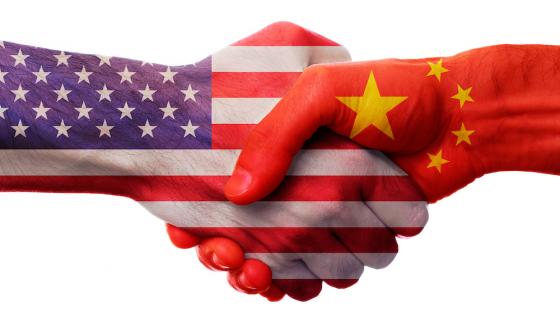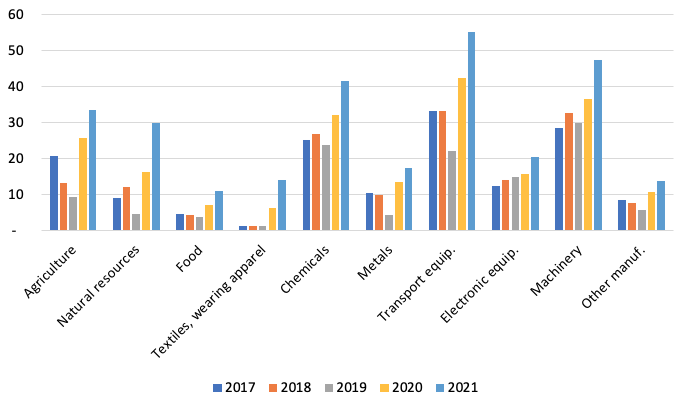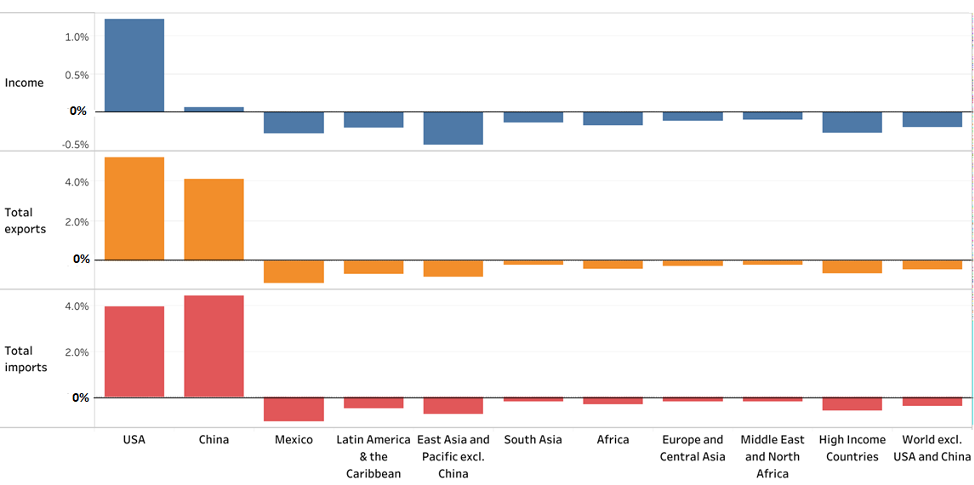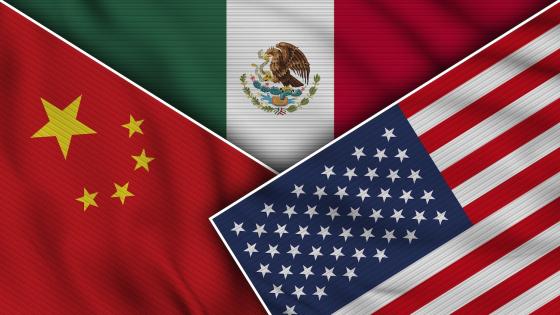The economic consequences of the trade tensions between China and the US have been the subject of a growing economic literature, largely focused on the economic effects on the US. Evidence shows that US importers are largely paying the tariffs (Amiti et al. 2019, Fajgelbaum et al. 2020), US retailers have seen falling profit margins (Cavallo et al. 2019), and exporters dependent on foreign inputs have suffered (Handley et al. 2020). As a result of these economic costs, support for Republican candidates in the most negatively affected regions has faltered (Blanchard et al. 2020).
In our recent work (Freund et al. 2020), we take a first look at the potential effects on trade and income of the trade agreement signed by China and the US in January 2020. We find that the implications of the agreement for third countries and for China largely depend on how China implements the deal. Specifically, we quantify the impact of import targets – the defining feature of the agreement – with a global dynamic computable general equilibrium model, Linkage, which uses the GTAP database (Freund et al. 2018). The model tracks historical GDP growth, trade balances and investment up to 2019 and then projects the developments in the global economy up to 2025.1 The commitments of China to buy more American goods and services as per the text of the agreement are aggregated to the CGE model sectors (Figure 1).
Figure 1 Chinese imports of goods from the US ($ billion) in 2017-2019 and quantitative targets under the China-US agreement in 2020-2021.
Source: WITS and authors’ assumptions based on China-US trade agreement.
Note: 2019 has been estimated based on Jan-Nov 2019 data.
We present three main comparisons.
- First, we compare managed trade with a baseline where there is no agreement. Tariffs are assumed to remain unchanged at end-2019 levels and China meets the import targets by subsidising imports of goods and services from the US – either explicitly or implicitly through the purchases of state-owned firms.
- Second, we compare managed trade with a trade war in which US-China tariffs escalate, in order to understand what led to the agreement.2
- Finally, we compare a situation in which China meets the import targets from the US through a non-discriminatory reduction of tariff and non-tariff barriers rather than through managed trade.
Three main findings emerge from the analysis.
1. Managed trade is better for the US (and Mexico) but makes everyone else worse off
Compared to the status quo, an expansion of US exports to the still-protected Chinese market delivers significant benefits for the US, with total income up by 0.9% and total exports up by 3% in 2021 (Figure 2). But these gains come at the expense of nearly all other countries. China loses 0.4% of its income in 2021 because of the inefficient diversion of trade away from other more efficient sources, even though there is also significant trade creation.
The impact on the rest of the world is also negative, with income down by 0.17 % and trade lower by about 0.3% in 2021. The biggest loss of income and exports is in East Asia and the Pacific (excluding China) (-0.32% and -0.5%, respectively, in 2021), followed by Latin America (-0.27% and -0.7%, respectively, in 2021). For Mexico, the benefits are indirect and driven by the improved US access to China’s market through strong input-output linkages with the US.
Figure 2 Impacts of the managed trade scenario as compared to the trade policy status quo scenario
2. Managed trade is better than trade war for the US and China but makes everyone else worse off
Compared to an escalation of the trade war, managed trade improves the outcome for both the US and China. The impact on the US is significant, with income up by 1.2% and total exports up by 5% in 2021 (Figure 3). The impact on Chinese income is smaller but also positive. The impact on the rest of the world is negative, with income down by 0.2% and exports down by 0.45% in 2021. The biggest loss of income and exports is expected in East Asia (-0.43% and -0.8%, respectively, in 2021), followed by Latin America (-0.21% and -0.6%, respectively, in 2021).
The negative impact on the rest of the world is predominantly due to trade diversion, as China imports less from other partners. Losses are more extensive than in the previous scenario because in the trade war scenario, exporters from the rest of the world benefit from higher effective preferences in both markets. The negative impact on Latin America is driven by agricultural goods and in East Asia by manufacturing goods. This effect is only in part driven by the reversal of the tariff preferences that China implicitly granted to the rest of the world as it raised tariffs on goods from the US in 2018 and 2019.
Figure 3 Impacts of the managed trade scenario as compared to the trade war scenario
3. Achieving the import targets of the China-US agreement through multilateral liberalization by China rather than managed trade would leave all countries, other than the US and Mexico, better off
We next assess the impact of the China-US agreement when import targets are met through multilateral liberalisation rather than managed trade. Specifically, we compare the managed trade deal with the multilateral liberalisation by China (a 15% reduction in tariffs and non-tariff barriers) that achieves the same gains in US exports to China as targeted under the agreement.
Simulation results show that the US is better off with China’s multilateral liberalisation relative to a trade war, but less so than with managed trade because it does not get preferential access to the Chinese market (Figure 4). This is due to a negative terms of trade effect for the US. Because China’s aggregate imports surge substantially more, the price US exporters receive is lower when China opens multilaterally than when the US receives preferential access. Due to the vertical linkages between the Mexican and the US economies, the fate of Mexico is closely tied to that of the US and it experiences a small loss relative to the managed trade scenario.
All other countries, including China, are better off with multilateral liberalization by China. Global income rises by the largest amount, more than half a percent, in this scenario. The largest income gains would be registered in Latin America and other high-income countries (1.1% and 1.2%, respectively). But African countries would also experience large increases in income (0.8%) driven by higher exports.
Figure 4 Impact of the multilateral liberalization scenario compared to the managed trade scenario
Conclusion
The China-US trade agreement has provoked contrasting sentiments. Relief because the agreement averts (at least temporarily) a damaging trade war. Anguish because the agreement to grant the US selective, preferential access to the Chinese market breaks multilateral rules that prohibit (at least in principle) discrimination between trading partners. In this column we have argued that the implications of the agreement for developing countries depend on how China implements it.
If China accommodates US demands by granting it privileged access to a still-protected Chinese market, then the US will benefit but other countries and probably China will lose. If instead, China accommodates US demands by liberalising access to its market for all trading partners, then all countries, including the US and China, would benefit. Therefore, an exercise in bilateral mercantilism can, by offering China an added incentive to open its markets to all, become an instrument for multilateral liberalization.
Authors’ note: The views expressed in this column are those of the authors and they do not necessarily represent the views of the World Bank Group.
References
Amiti, M, S J Redding, and D Weinstein (2019), “The Impact of the 2018 Trade War on U.S. Prices and Welfare,” Journal of Economic Perspectives 33(4): 187–210.
Blanchard, E J, C P Bown, and D Chor (2019), “Did Trump’s Trade War Impact the 2018 Election?”, NBER Working Paper No. 26434.
Cavallo, A, B Neiman, G Gopinath, and J Tang (2019), “Tariff Passthrough at the Border and at the Store: Evidence from US Trade Policy”, NBER Working Paper 26396.
Fajgelbaum, P D, P K Goldberg, P J Kennedy, and A K Khandelwal (2020), “The Return to Protectionism,” The Quarterly Journal of Economics 135(1): 1–55.
Freund, C, M J Ferrantino, M Maliszewska and M Ruta (2018), “Impacts on Global Trade and Income of Current Trade Disputes”, MTI Practice Note No. 2, World Bank Group.
Freund, C, M Maliszewska, A Mattoo and M Ruta (2020), “When Elephants Make Peace: The Impact of the China-U.S. Trade Agreement on Developing Countries”, World Bank Policy Research Working Paper No. 9173.
Handley, K, F Kamal and R Monarch (2020), “Rising Import Tariffs, Falling Export Growth: When Modern Supply Chains Meet Old-Style Protectionism”, NBER Working Paper No. 26611.
Endnotes
1 The import targets in 2020 may be less feasible in light of the negative demand shock from the coronavirus. As the focus of this column is on the trade agreement and the extent and duration of the coronavirus shock is uncertain, the scenarios assume demand in 2020 is not necessarily affected by the virus. To the extent demand is lower for the year in China, an attempt to reach the import targets will lead to more trade diversion and a larger loss in income for China and the rest of the world.
2 The “trade war” scenario assumes that both China and the US impose 25 percentage point surcharges on trade from each other.










